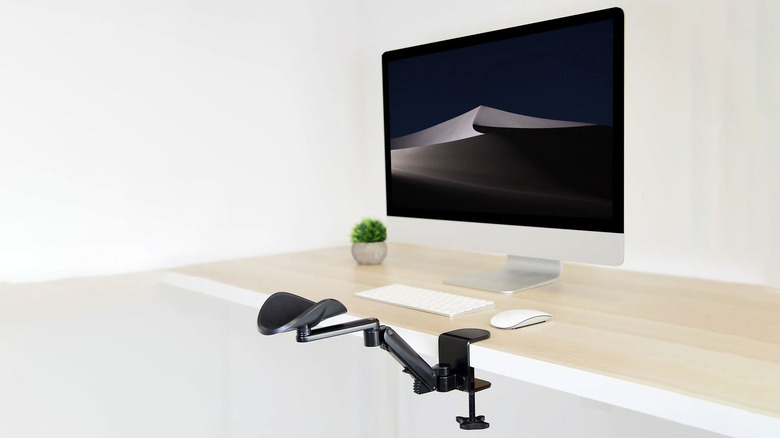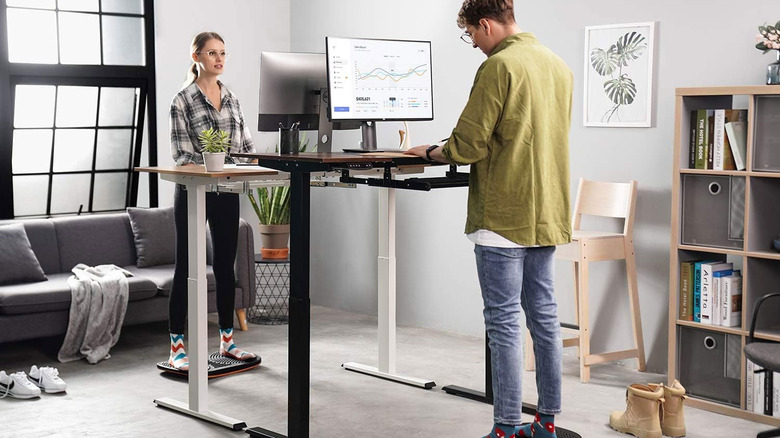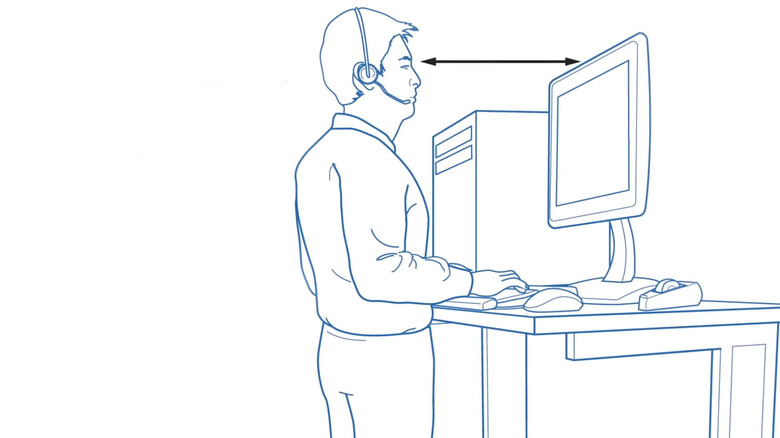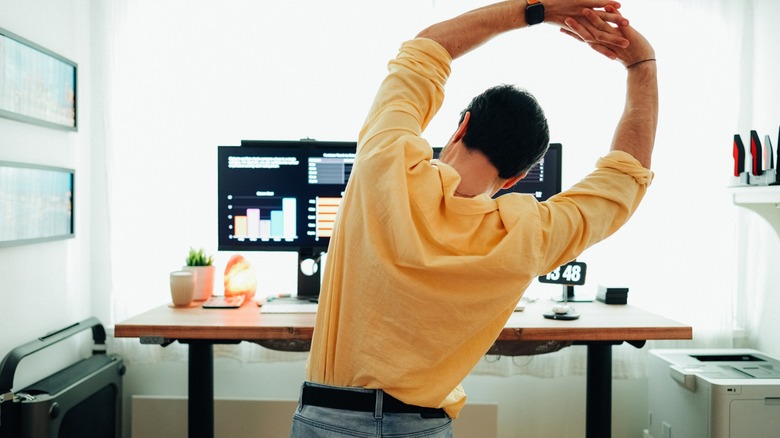5 Of The Best Standing Desk Lifehacks To Master Your Space
As technology has steadily advanced over time, so has the workplace. Most of today's modern workers are more used to sitting in front of a computer for most of the day than standing, as the typical 9–5 has significantly changed over the past few decades. But just because overall working conditions have improved for many worldwide doesn't mean that sitting in a sedentary position is better for you.
Indeed, according to most doctors, an inactive lifestyle can result in weight gain, muscle loss, and worse blood circulation. In fact, according to the Annals of Internal Medicine, a sedentary lifestyle may also be linked to a greater risk of diabetes and heart disease.
Luckily, one clever way office workers have helped mitigate this is by using standing desks to stay more active while working. However, buying a standing desk is just the start, as the piece of equipment itself isn't the key to unlocking better health. Luckily, there are standing desk hacks and tips to ensure you're making optimal use of your space.
Set alarms in intervals to get your blood flowing
Contrary to the point of having a standing desk, sitting and walking around intermittently while using a standing desk is the best approach. Just as sitting constantly is not good for your body, standing all day in a stationary position is not great either. Instead, people should focus on creating a somewhat regimented schedule using an alarm, smart clock, or phone app to remind them to stand, sit down, and take a walk. Better yet, the alarm can also remind people to drink water for even greater health benefits.
The intervals between alarms should be whatever is most comfortable to you and your body type, and you can break up your intervals however you please. So, for instance, you could sit for 15 minutes, stand for 45 minutes, then take a short stroll. Or, if you'd prefer, you could stand for 15 minutes, sit for 45, and ease your way into using your standing desk more. Whatever is most comfortable for your body is what you should do.
Mountable armrests can help with posture and fatigue
One of the main downsides of utilizing a standing desk is that people will often lean or hunch over their desks as the day goes on. Maintaining good posture throughout the day is hard, and your elbows should be at about a 90-degree angle to maintain the best posture. If you find yourself getting fatigued as the day wears on and you end up leaning on your desk, it's defeating the purpose of using a standing desk in the first place.
Mountable armrests that can attach to your desk are widely available online. This equipment can help regulate your posture and help with fatigue throughout the day, making a huge difference in how you feel. Different kinds of these are available, from smaller brackets that just fit your forearms to desk extenders that can act as extra space for a keyboard and mouse.
Use an anti-fatigue mat to help with foot and knee pain
Anyone who has had a job that required them to stand all day knows how hard it can be on their feet and knees. One way to mitigate this pain or eliminate it is by getting a softer surface to stand on throughout the day. Anti-fatigue mats are foamy soft mats that are more accommodating to your feet than a hard surface.
There are a variety of fatigue mats that can help relieve stress off your feet and joints, including ergonomic anti-fatigue mat designs that tilt and shift depending on your weight distribution. Footwear may also play a role in whether you experience joint or back pain. People also use treadmill desks to stay walking throughout the day, which may be an option. Regardless of the model you choose, having anything over a hard floor will help relieve stress on your body.
Learn how to stand properly
While it seems pretty silly that you'd have to "learn" how to stand the right way, it's true. For a standing desk to work properly, it needs to be raised to a position that's best for your posture. According to the Mayo Clinic, the top of your monitor should be just below eye level, and your elbows bent at a 90-degree angle with your hands below or at elbow level.
If your standing desk is not capable of this for whatever reason, consider getting an adjustable mount for your monitor so you can regulate it and the desk height. If you are slouching or leaning throughout the day, it may mean you should spend a bit more time sitting than standing because your body is telling you that you're fatigued.
It's also useful to move around while you stand at your desk. You can strike different poses to get active and moving and help blood flow, even if you're not taking many breaks to walk around. Just make sure that most of the time, when standing still, you're maintaining good posture.
Free the standing desk of clutter
Since you'll be raising and lowering the desk throughout the day to take breaks from standing, the desk itself must be set up in the proper way to be effective. Make sure there is ample space around the standing desk, and move things that might be in the way or that you're currently using for storage space. Things like drinks could spell doom for your electronic equipment, so consider a side table if you like to drink at your desk throughout the day.
Similarly, proper wire management is key to not pulling out computer wires or causing the hardware to fall over. Using things like sleeved wire covers or wire clips can help you avoid disaster. You should avoid DIY standing desks, as they often create more clutter and aren't at the proper height. Mental health is just as important as physical, and having a clean space to work in will pay dividends in the long run, especially if you're using a standing desk.





